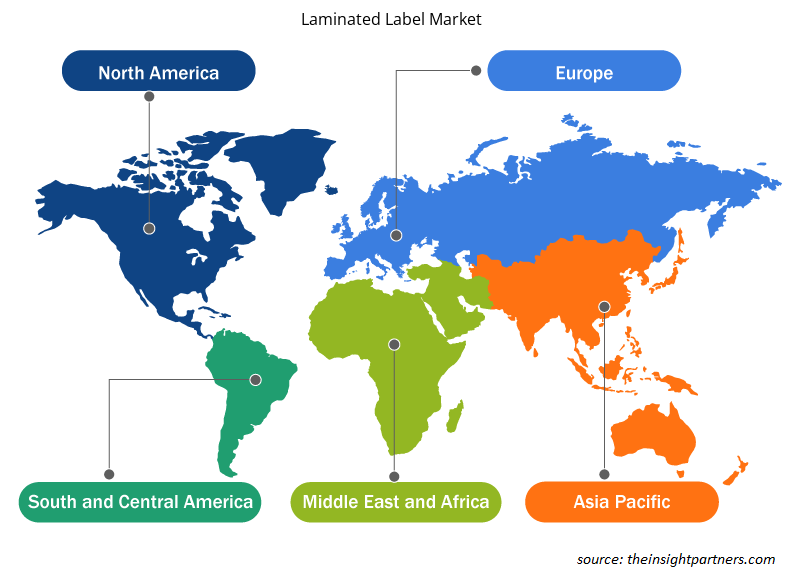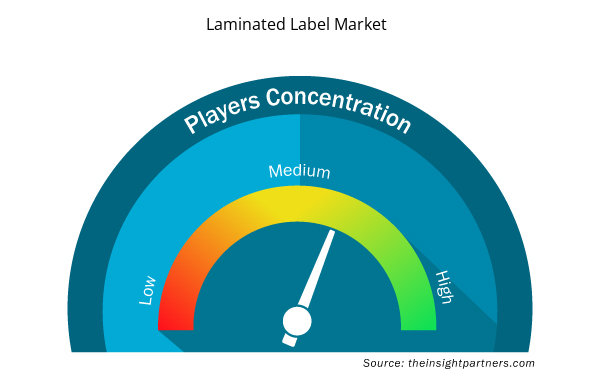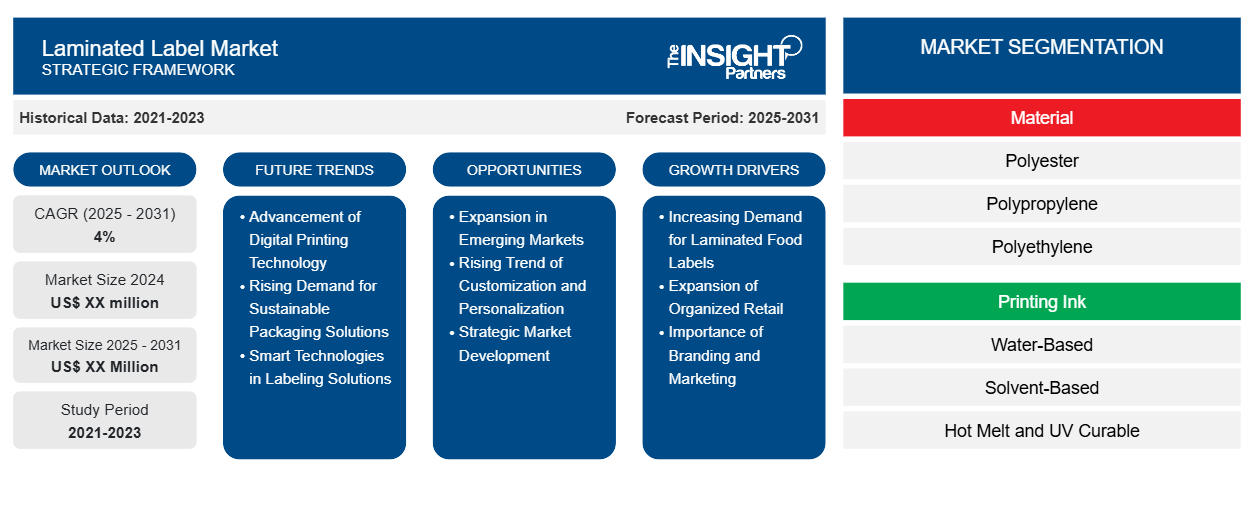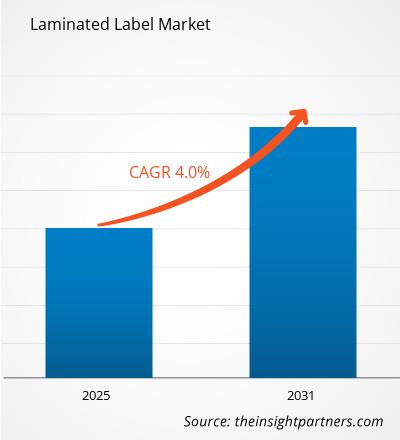Si prevede che il mercato delle etichette laminate registrerà un CAGR del 4% dal 2023 al 2031, con una dimensione di mercato in espansione da XX milioni di dollari USA nel 2023 a XX milioni di dollari USA entro il 2031.
Il rapporto è segmentato per materiale (poliestere, polipropilene, polietilene, vinile e altri) e inchiostro da stampa (a base d'acqua, a base di solvente, hot melt e UV). Il rapporto presenta inoltre analisi basate sul settore di utilizzo finale (cibo e bevande, beni di consumo, elettronica, cura della persona e cosmetici, prodotti farmaceutici e altri). L'analisi globale è ulteriormente suddivisa a livello regionale e nei principali paesi. Le dimensioni del mercato e le previsioni a livello globale, regionale e nazionale per tutti i principali segmenti di mercato sono coperte nell'ambito. Il rapporto offre il valore in USD per l'analisi e i segmenti di cui sopra. Il rapporto fornisce statistiche chiave sullo stato di mercato dei principali attori del mercato e offre tendenze e opportunità di mercato.
Scopo del rapporto
Il report Laminated Label Market di The Insight Partners mira a descrivere il panorama attuale e la crescita futura, i principali fattori trainanti, le sfide e le opportunità. Ciò fornirà spunti a vari stakeholder aziendali, come:
- Fornitori/produttori di tecnologia: per comprendere le dinamiche di mercato in evoluzione e conoscere le potenziali opportunità di crescita, consentendo loro di prendere decisioni strategiche informate.
- Investitori: condurre un'analisi completa delle tendenze in merito al tasso di crescita del mercato, alle proiezioni finanziarie del mercato e alle opportunità esistenti lungo la catena del valore.
- Enti di regolamentazione: regolamentano le politiche e le attività di controllo sul mercato allo scopo di ridurre al minimo gli abusi, preservare la fiducia degli investitori e sostenere l'integrità e la stabilità del mercato.
Segmentazione del mercato delle etichette laminate
Materiale
- Poliestere
- Polipropilene
- Polietilene
- Vinile e altri
Inchiostro da stampa
- A base d'acqua
- A base di solvente
- Hot Melt e polimerizzabile UV
Settore di utilizzo finale
- Cibo e bevande
- Beni di consumo
- Elettronica
- Cura della persona e cosmetici
- Prodotti farmaceutici e altri
Geografia
- America del Nord
- Europa
- Asia-Pacifico
- America del Sud e Centro
- Medio Oriente e Africa
Geografia
- America del Nord
- Europa
- Asia-Pacifico
- America del Sud e Centro
- Medio Oriente e Africa
Personalizza questo report in base alle tue esigenze
Riceverai la personalizzazione gratuita di qualsiasi report, comprese parti di questo report, o analisi a livello nazionale, pacchetto dati Excel, oltre a usufruire di grandi offerte e sconti per start-up e università
- Scopri le principali tendenze di mercato in questo rapporto.Questo campione GRATUITO includerà analisi di dati che spaziano dalle tendenze di mercato alle stime e alle previsioni.
Fattori di crescita del mercato delle etichette laminate
- Domanda crescente di etichette laminate per alimenti: il settore alimentare e delle bevande è particolarmente affezionato alle etichette laminate. Date le regole e le normative dettagliate relative all'etichettatura alimentare, questi produttori sono alla ricerca di etichette di alta qualità e di lunga durata che possano resistere anche alle peggiori condizioni di acqua, calore e attrito. Grazie alle proprietà di resistenza all'abrasione delle etichette laminate, i dettagli essenziali sui prodotti sono garantiti per rimanere in buone condizioni fino alla loro esaurimento. Con un numero crescente di consumatori che si orienta verso alimenti già confezionati e lavorati, si prevede che il mercato delle etichette laminate crescerà in modo incredibilmente rapido.
- Espansione del commercio al dettaglio organizzato: l'espansione del commercio al dettaglio e dell'e-commerce ha ulteriormente messo a dura prova le opportunità del mercato delle etichette laminate. Il passaggio allo shopping online ha aumentato la domanda di etichettatura, in particolare per quanto riguarda il marchio e l'identificazione dei prodotti quando le merci sono in transito. L'ambito delle etichette laminate non si limita al loro utilizzo funzionale, ma si estende anche alle attività promozionali aziendali. L'alleggerimento delle restrizioni sulla pubblicità e la necessità di etichette con scudo pittorico, sorprendente e antimanomissione sui prodotti venduti direttamente al consumatore su Internet sta stimolando le attività in molti segmenti della vendita al dettaglio.
- Importanza del branding e del marketing: il branding e il marketing sono diventati uno dei fattori più critici che motivano i consumatori ad acquistare un articolo nel mercato attuale. Per questo motivo, le aziende hanno iniziato a produrre etichette migliori e più accattivanti per i loro prodotti, cercando di battere i loro rivali. Le etichette laminate hanno un aspetto squisito e possono essere disponibili in diversi colori, strutture e finiture che possono ravvivare l'intero imballaggio. Ciò è più pronunciato nei settori dei prodotti cosmetici e per la cura della persona e della casa e nella necessità di soluzioni di etichettatura laminate.
Tendenze future del mercato delle etichette laminate
- Avanzamento della tecnologia di stampa digitale: la trasformazione del settore delle etichette laminate è stata notevolmente influenzata dall'avanzamento della tecnologia di stampa digitale. Facilita la produzione anche della più piccola raccolta di segnaletica contenente immagini e colori brillanti a un ritmo rapido. La stampa digitale apre le porte a personalizzazioni di etichette efficienti da parte dei produttori per i loro clienti che rispondono a etichette di qualsiasi tipo. La possibilità di offrire prodotti con etichette personalizzate a costi di installazione minimi o nulli sta rivoluzionando questo mercato, rendendolo favorevole alle piccole imprese e alle startup.
- Domanda crescente di soluzioni di imballaggio sostenibili: poiché il riscaldamento globale è sempre più al centro dell'agenda, il mercato delle etichette laminate più ortodosso tende anche a produrre una nuova generazione di etichette laminate ecologiche. Sempre più produttori affrontano la questione dei materiali riciclabili avanzati, ad esempio pellicole degradabili e colle biodegradabili, per produrre etichette meno dannose per la natura. Affrontare questi aspetti non solo soddisfa le esigenze dei clienti che cercano prodotti più rispettosi dell'ambiente, ma risponde anche alla crescente domanda delle autorità in materia di sostenibilità. Ciò, a sua volta, sta aumentando la preoccupazione e l'attenzione nell'aggiungere caratteristiche sostenibili alle soluzioni di etichettatura, aumentando la concorrenza nel mercato delle soluzioni di etichettatura laminate.
- Tecnologie intelligenti nelle soluzioni di etichettatura: una tendenza emergente nel mercato delle etichette laminate è la sovrapposizione di tecnologie intelligenti nelle soluzioni di etichettatura. L'implementazione di tali sistemi può coprire la confezione con etichette intelligenti contenenti codici QR, tag NFC o chip RFID, consentendo al marchio di fornire informazioni sul prodotto e persino di interagire con il consumatore. Ciò fornisce un valore aggiunto all'utilizzo di etichette laminate in quanto consentono alle aziende di gestire gli articoli in magazzino, mantenere registri di prodotto e raccogliere i dati dei clienti. Con la crescente penetrazione della tecnologia intelligente, crescerà anche l'opportunità di accedere alle etichette laminate per le loro buffonate migliorate.
Opportunità di mercato per le etichette laminate
- Espansione nei mercati emergenti: è un buon momento per i produttori di etichette laminate per fare un passo avanti in nuovi territori, specialmente in Asia-Pacifico, America Latina e Africa. C'è un aumento della domanda di prodotti confezionati e di sistemi di etichettatura efficaci in queste aree a causa della loro rapida urbanizzazione e del miglioramento dello stato economico delle persone e della classe media emergente. I mercati locali possono essere inseriti con successo tramite un'adeguata localizzazione del prodotto e la collaborazione con i distributori locali.
- Tendenza crescente di personalizzazione e customizzazione: il mercato delle etichette laminate è destinato a trarre notevoli vantaggi dal continuo cambiamento di gusti e preferenze verso la personalizzazione di massa e la customizzazione dei prodotti. Oggigiorno, si può osservare più spesso che i marchi desiderano soluzioni di etichettatura uniche che siano distinguibili da qualsiasi altra e che si colleghino in modo notevole con i consumatori. Questo è un fattore importante per i produttori, in quanto possono fornire opzioni di personalizzazione come la stampa di dati variabili, forme e texture diverse. Ciò contribuirà a rafforzare la fedeltà al marchio nel mercato dei consumatori e ad assistere nella gestione del marchio.
- Sviluppo strategico del mercato: ci sono molte possibilità per i produttori di etichette laminate di espandere la propria attività, ad esempio, tramite fusioni e acquisizioni o alleanze strategiche con aziende coinvolte nel packaging, nella logistica o nella vendita al dettaglio. Ad esempio, unire le forze con un'azienda di packaging o di e-commerce può consentire alle aziende di offrire alcuni servizi confezionati in cui le etichette laminate saranno incluse nella catena di fornitura del packaging. Con un orientamento a questo particolare gruppo, le aziende possono ottenere maggiore visibilità nel mercato locale e promuovere prodotti adeguati in base alle tendenze, all'evoluzione e alle esigenze del mercato.
Approfondimenti regionali sul mercato delle etichette laminate
Le tendenze regionali e i fattori che influenzano il mercato delle etichette laminate durante il periodo di previsione sono stati ampiamente spiegati dagli analisti di Insight Partners. Questa sezione discute anche i segmenti e la geografia del mercato delle etichette laminate in Nord America, Europa, Asia Pacifico, Medio Oriente e Africa e Sud e Centro America.

- Ottieni i dati specifici regionali per il mercato delle etichette laminate
Ambito del rapporto sul mercato delle etichette laminate
| Attributo del report | Dettagli |
|---|---|
| Dimensioni del mercato nel 2023 | XX milioni di dollari USA |
| Dimensioni del mercato entro il 2031 | XX milioni di dollari USA |
| CAGR globale (2023-2031) | 4% |
| Dati storici | 2021-2022 |
| Periodo di previsione | 2024-2031 |
| Segmenti coperti | Per materiale
|
| Regioni e Paesi coperti | America del Nord
|
| Leader di mercato e profili aziendali chiave |
|
Densità dei player del mercato delle etichette laminate: comprendere il suo impatto sulle dinamiche aziendali
Il mercato delle etichette laminate sta crescendo rapidamente, spinto dalla crescente domanda degli utenti finali dovuta a fattori quali l'evoluzione delle preferenze dei consumatori, i progressi tecnologici e una maggiore consapevolezza dei vantaggi del prodotto. Con l'aumento della domanda, le aziende stanno ampliando le loro offerte, innovando per soddisfare le esigenze dei consumatori e capitalizzando sulle tendenze emergenti, il che alimenta ulteriormente la crescita del mercato.
La densità degli operatori di mercato si riferisce alla distribuzione di aziende o società che operano in un particolare mercato o settore. Indica quanti concorrenti (operatori di mercato) sono presenti in un dato spazio di mercato in relazione alle sue dimensioni o al valore di mercato totale.
Le principali aziende che operano nel mercato delle etichette laminate sono:
- Azienda 3M
- Società Avery Dennison
- Società a responsabilità limitata Bemis Company, Inc.
- CCL Industries Inc. 5 . Constantia Flexibles Group GmbH
- Società a responsabilità limitata Coveris Holdings SA
Disclaimer : le aziende elencate sopra non sono classificate secondo un ordine particolare.

- Ottieni una panoramica dei principali attori del mercato delle etichette laminate
Punti di forza chiave
- Copertura completa: il rapporto esamina in modo completo i prodotti, i servizi, le tipologie e gli utenti finali del mercato delle etichette laminate, offrendo una panoramica olistica.
- Analisi degli esperti: il rapporto è compilato sulla base della conoscenza approfondita di esperti e analisti del settore.
- Informazioni aggiornate: il rapporto garantisce la pertinenza aziendale grazie alla copertura di informazioni recenti e tendenze nei dati.
- Opzioni di personalizzazione: questo report può essere personalizzato per soddisfare le esigenze specifiche del cliente e adattarsi in modo appropriato alle strategie aziendali.
Il rapporto di ricerca sul mercato delle etichette laminate può, quindi, aiutare a guidare il percorso di decodifica e comprensione dello scenario del settore e delle prospettive di crescita. Sebbene possano esserci alcune preoccupazioni valide, i vantaggi complessivi di questo rapporto tendono a superare gli svantaggi.
- Analisi storica (2 anni), anno base, previsione (7 anni) con CAGR
- Analisi PEST e SWOT
- Valore/volume delle dimensioni del mercato - Globale, regionale, nazionale
- Industria e panorama competitivo
- Set di dati Excel



Report Coverage
Revenue forecast, Company Analysis, Industry landscape, Growth factors, and Trends

Segment Covered
This text is related
to segments covered.

Regional Scope
North America, Europe, Asia Pacific, Middle East & Africa, South & Central America

Country Scope
This text is related
to country scope.
Domande frequenti
Based on geography, Asia Pacific held the significant share of the laminated label market due to growth in the end-use industries
Advancement in digital printing technology is expected to be the key market trends
Based on end-use industry, consumer goods segment is expected to witness the fastest growth during the forecast period
Growth in the e-commerce and retail sector is driving the market growth
3M; Avery Dennison Corporation; CCL Industries; Lecta Adestor; Flexcon Company, Inc are some of the key players operating in the laminated label market
The Laminated Label Market is estimated to witness a CAGR of 4% from 2023 to 2031
Trends and growth analysis reports related to Chemicals and Materials : READ MORE..
1. 3M Company
2. Avery Dennison Corporation
3. Bemis Company, Inc.
4. CCL Industries Inc.
5 . Constantia Flexibles Group GmbH
6. Coveris Holdings S.A.
7. Flexcon Company, Inc.
8. R.R. Donnelley and Sons Company
9. Stickythings Limited
10. Torraspapel Adestor
The Insight Partners performs research in 4 major stages: Data Collection & Secondary Research, Primary Research, Data Analysis and Data Triangulation & Final Review.
- Data Collection and Secondary Research:
As a market research and consulting firm operating from a decade, we have published and advised several client across the globe. First step for any study will start with an assessment of currently available data and insights from existing reports. Further, historical and current market information is collected from Investor Presentations, Annual Reports, SEC Filings, etc., and other information related to company’s performance and market positioning are gathered from Paid Databases (Factiva, Hoovers, and Reuters) and various other publications available in public domain.
Several associations trade associates, technical forums, institutes, societies and organization are accessed to gain technical as well as market related insights through their publications such as research papers, blogs and press releases related to the studies are referred to get cues about the market. Further, white papers, journals, magazines, and other news articles published in last 3 years are scrutinized and analyzed to understand the current market trends.
- Primary Research:
The primarily interview analysis comprise of data obtained from industry participants interview and answers to survey questions gathered by in-house primary team.
For primary research, interviews are conducted with industry experts/CEOs/Marketing Managers/VPs/Subject Matter Experts from both demand and supply side to get a 360-degree view of the market. The primary team conducts several interviews based on the complexity of the markets to understand the various market trends and dynamics which makes research more credible and precise.
A typical research interview fulfils the following functions:
- Provides first-hand information on the market size, market trends, growth trends, competitive landscape, and outlook
- Validates and strengthens in-house secondary research findings
- Develops the analysis team’s expertise and market understanding
Primary research involves email interactions and telephone interviews for each market, category, segment, and sub-segment across geographies. The participants who typically take part in such a process include, but are not limited to:
- Industry participants: VPs, business development managers, market intelligence managers and national sales managers
- Outside experts: Valuation experts, research analysts and key opinion leaders specializing in the electronics and semiconductor industry.
Below is the breakup of our primary respondents by company, designation, and region:

Once we receive the confirmation from primary research sources or primary respondents, we finalize the base year market estimation and forecast the data as per the macroeconomic and microeconomic factors assessed during data collection.
- Data Analysis:
Once data is validated through both secondary as well as primary respondents, we finalize the market estimations by hypothesis formulation and factor analysis at regional and country level.
- Macro-Economic Factor Analysis:
We analyse macroeconomic indicators such the gross domestic product (GDP), increase in the demand for goods and services across industries, technological advancement, regional economic growth, governmental policies, the influence of COVID-19, PEST analysis, and other aspects. This analysis aids in setting benchmarks for various nations/regions and approximating market splits. Additionally, the general trend of the aforementioned components aid in determining the market's development possibilities.
- Country Level Data:
Various factors that are especially aligned to the country are taken into account to determine the market size for a certain area and country, including the presence of vendors, such as headquarters and offices, the country's GDP, demand patterns, and industry growth. To comprehend the market dynamics for the nation, a number of growth variables, inhibitors, application areas, and current market trends are researched. The aforementioned elements aid in determining the country's overall market's growth potential.
- Company Profile:
The “Table of Contents” is formulated by listing and analyzing more than 25 - 30 companies operating in the market ecosystem across geographies. However, we profile only 10 companies as a standard practice in our syndicate reports. These 10 companies comprise leading, emerging, and regional players. Nonetheless, our analysis is not restricted to the 10 listed companies, we also analyze other companies present in the market to develop a holistic view and understand the prevailing trends. The “Company Profiles” section in the report covers key facts, business description, products & services, financial information, SWOT analysis, and key developments. The financial information presented is extracted from the annual reports and official documents of the publicly listed companies. Upon collecting the information for the sections of respective companies, we verify them via various primary sources and then compile the data in respective company profiles. The company level information helps us in deriving the base number as well as in forecasting the market size.
- Developing Base Number:
Aggregation of sales statistics (2020-2022) and macro-economic factor, and other secondary and primary research insights are utilized to arrive at base number and related market shares for 2022. The data gaps are identified in this step and relevant market data is analyzed, collected from paid primary interviews or databases. On finalizing the base year market size, forecasts are developed on the basis of macro-economic, industry and market growth factors and company level analysis.
- Data Triangulation and Final Review:
The market findings and base year market size calculations are validated from supply as well as demand side. Demand side validations are based on macro-economic factor analysis and benchmarks for respective regions and countries. In case of supply side validations, revenues of major companies are estimated (in case not available) based on industry benchmark, approximate number of employees, product portfolio, and primary interviews revenues are gathered. Further revenue from target product/service segment is assessed to avoid overshooting of market statistics. In case of heavy deviations between supply and demand side values, all thes steps are repeated to achieve synchronization.
We follow an iterative model, wherein we share our research findings with Subject Matter Experts (SME’s) and Key Opinion Leaders (KOLs) until consensus view of the market is not formulated – this model negates any drastic deviation in the opinions of experts. Only validated and universally acceptable research findings are quoted in our reports.
We have important check points that we use to validate our research findings – which we call – data triangulation, where we validate the information, we generate from secondary sources with primary interviews and then we re-validate with our internal data bases and Subject matter experts. This comprehensive model enables us to deliver high quality, reliable data in shortest possible time.


 Ottieni un campione gratuito per questo repot
Ottieni un campione gratuito per questo repot